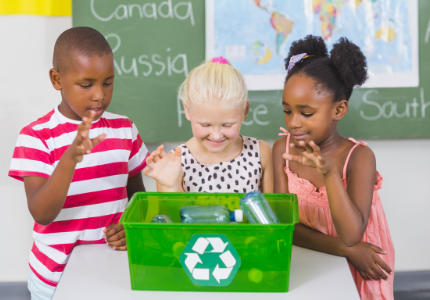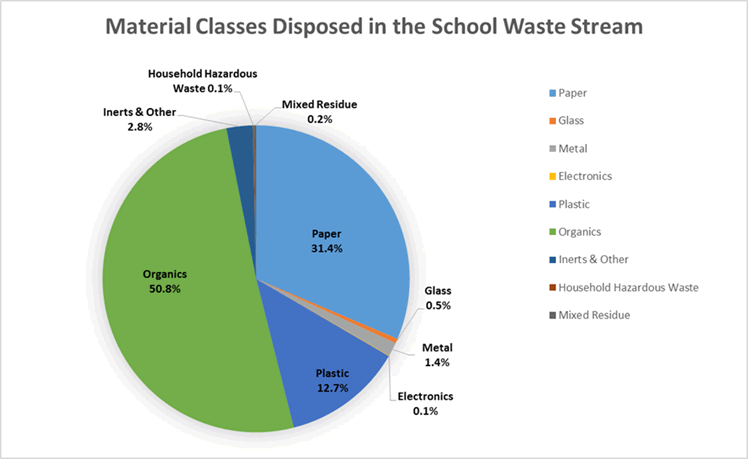School Waste Composition
School Waste Characterization Data
Waste characterization means finding out how much paper, glass, food waste, etc. is discarded in your waste stream. This typically involves collecting, sorting, and weighing waste generated at schools and district facilities. Waste characterization information helps in planning how to reduce waste, set up recycling programs, and conserve money and other resources.
A school district does not need to complete a comprehensive waste characterization study to estimate the composition of its waste stream. CalRecycle has collected and prepared school waste characterization data that can help plan new waste reduction programs and evaluate existing efforts. The following chart illustrates the estimated composition of waste disposed by schools in California. These data may not be representative of the waste composition of your school or school district. For further information, see data limitations and details below.
Information can be found below on conducting a school waste characterization audit (waste audit) and waste assessment for program planning or instructional purposes.
Material Classes Disposed in the School Waste Stream
| Material Type | Percent (%) of Waste Stream |
|---|---|
| Electronics | 0.1% |
| Glass | 0.5% |
| Household Hazardous Waste | 0.1% |
| Inerts and Other | 2.8% |
| Metal | 1.4% |
| Mixed Residue | 0.2% |
| Organics | 50.8% |
| Paper | 31.4% |
| Plastic | 12.7% |
To learn more about the specific materials within each category listed on the graph, see the material type class constituents.
Data Limitations and Details
Disposal composition data was developed using 45 samples of waste from K-12 schools from CalRecycle’s 2014 waste characterization study and represents statewide average data.
The pie chart represents materials disposed and does not include materials recycled. Different schools have different recycling programs, which affect the type of remaining materials disposed. This chart may not reflect the waste stream of a particular school or district.
Waste Audit versus Waste Assessment
The objective of a school waste audit is to introduce the idea to your students and staff that garbage doesn’t just disappear once it is collected in a garbage can. You can’t just throw it away. It can be compacted, buried, or changed to ash and vapor but the garbage must all go somewhere. A waste audit is a method of determining the school district’s waste characterization, which is the component within the waste assessment that details what is being thrown away (such as the type, quantity, and origin of waste produced). In addition to a waste audit, an effective waste assessment identifies and evaluates school district policies and procedures that affect waste generation.
A waste assessment is a broad method of documenting and evaluating what is entering the school district and analyzing what is being disposed (waste characterization). This consists of interviews and site visits to district facilities. Interviews are conducted with the superintendent, chief business official, and managers from each school district department (for example, business services, transportation, purchasing, and child nutrition). A waste assessment also includes an evaluation of district purchases and how resources are used. The waste assessment can be used as a tool to identify wasteful practices and create opportunities to increase efficiency, reduce waste, and lower costs.
When examining the district’s resources, it is helpful to ask these questions:
- Do we need this?
- Can we use less?
- Can we reuse it?
- Can we recycle it?
- Can we use it more efficiently?
Using the information from a school district waste assessment, a report can be prepared to:
- Explain the purpose of the waste assessment
- Describe the methodology used
- Document the current waste management system
- Estimate waste composition
- Identify waste reduction opportunities
- Recommend waste reduction policy and operating procedures
- Recommend best management practices
- Describe opportunities for implementation
- Provide local and state resource and contact information (recycling coordinator, recyclers, funding opportunities, etc.)
A copy of the waste assessment report should be provided to the district superintendent for implementation consideration. The waste assessment can be used to:
- Identify waste reduction priorities
- Write a plan of action
- Track program progress
- Make program adjustments
- Gain recognition for the district’s efforts and opportunities
A waste assessment can also be integrated into classroom instruction as an example of environment-based education–using the environment as a tool for achieving broader educational goals.
Waste Assessment and Audit Resources
Los Angeles County Generation Earth. How-to-guides and worksheets for completing a school or classroom waste audit.
StopWaste.Org outlines tools to help you conduct your own school waste audit and action project.
For more information contact: Schools Program, Schools@calrecycle.ca.gov.

